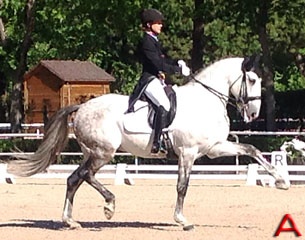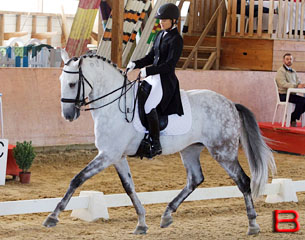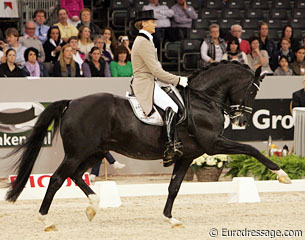
Recently I have begun using myself as the example to help explain what is right and wrong, according to the FEI objectives. As a rider I do get confused. I have had a few people contact me lately saying that at judges' clinics they are told that a horse with an exaggerated foreleg, which did not match the hind leg and which had a modest overtrack in extended trot, deserved a 7. However, if you read the FEI rules they state that "the movement of the fore and hind legs should reach equally forward in the moment of extension."
Photo A is therefore not correct. Instead of just taking my word for it, I thought I would ask some experts on what the difference is, and why, according to the FEI objectives, one is incorrect.
Equine biomechanics expert Hilary Clayton explains that in the photo with the more extravagant front leg and slower hind leg the movements of the fore and hind legs are no longer synchronised and the parallel relationship between the hind cannon and the forearm has been lost.
“For me this makes the gait somewhat impure because the diagonal limbs are not rotating synchronously. The horse is uphill though and will likely have a hind-first dissociation,” said Hilary. “Something to be aware of is that when the horse is in self carriage the foreleg is pulled back a long way before it contacts the ground – in fact, if the horse shows good self carriage the foreleg will be only slightly ahead of the vertical at the moment of contact and will be pulled back to only a small angle behind the vertical before the hoof leaves the ground. So it’s a characteristic of self carriage that the foreleg is close to vertical throughout the entire time it’s on the ground because this supports the withers at their highest position. (Same thing in piaffe – keep the foreleg vertical to maximise the elevation in front). Remember that the forces on the legs are much greater when the hoof is on the ground (stance phase) than when the leg is swinging through the air (swing phase). So in terms of limb loading a more extravagant movement as the leg swings forward is probably not having much effect on limb loading.”
While this may not necessarily point out limb loading, and therefore more likely lead to injury, the illustration in Photo B is far more harmonious, with synchronisation between the back and front legs. “I really like the photo (Photo B) where the hind cannons are parallel with the forearms which indicates that the movements of the diagonal limb pairs are correctly synchronised – in other words swinging forward (protracting) and swinging backward (retracting) synchronously," Hilary explained. “Also the hind leg is stepping nicely forward. The horse is clearly in an uphill frame so I would anticipate that the hind hoof will contact the ground slightly before the diagonal front hoof (hind-first diagonal dissociation). This will not be visible just from watching the horse but you’ll see it on slow motion replay. This is not an impurity of the gait – it’s just a consequence of the horse being beautifully uphill.
“I really like the photo (Photo B) where the hind cannons are parallel with the forearms which indicates that the movements of the diagonal limb pairs are correctly synchronised – in other words swinging forward (protracting) and swinging backward (retracting) synchronously," Hilary explained. “Also the hind leg is stepping nicely forward. The horse is clearly in an uphill frame so I would anticipate that the hind hoof will contact the ground slightly before the diagonal front hoof (hind-first diagonal dissociation). This will not be visible just from watching the horse but you’ll see it on slow motion replay. This is not an impurity of the gait – it’s just a consequence of the horse being beautifully uphill.
Hilary has also noted that very interestingly in her recent research, “hind-first dissociation is associated with less concussion on the horse’s legs than when the diagonal hooves hit the ground at the same time, so the slight dissociation reduces the risk of developing arthritic changes”.
So why then do we quite often see an extravagant front leg, and a lack of synchrony between the front and back legs, in high level competition?
Colonel Christian Carde, retired French I-judge, former French national coach and former chief rider of the Cadre Noir in Saumur, France says the “reason why we don’t see enough correct trots in a harmonious frame these days, is due to one major reason: the contact is obtained with too much tension of the reins. That makes the horse too generous in front and less behind.”
This explanation makes complete sense to me, because on the day the photo was taken with Batialo showing an extravagant front leg, Photo A, I was having a lot of trouble controlling him and due to my own nervousness and tension I was unconsciously holding him in front.
In Photo B I was confident, Batialo was relaxed, and I was able to allow with the rein, and properly establish a trot based on what the FEI objectives point out as correct.
 When looking at photos it’s great to be critical and it’s also good to remember that there will often be a bad moment in time, but you have to look at the big picture. At my first ever test on Batialo they took 200 photos and only 4 were ok. In the last test we did they again took 200 photos, and only 4 were pretty average, mainly because my tongue was poking out or my right leg had flown off into outer space.
When looking at photos it’s great to be critical and it’s also good to remember that there will often be a bad moment in time, but you have to look at the big picture. At my first ever test on Batialo they took 200 photos and only 4 were ok. In the last test we did they again took 200 photos, and only 4 were pretty average, mainly because my tongue was poking out or my right leg had flown off into outer space.
However, if this incorrect trot is celebrated, or rewarded by judges, then perhaps we are losing sight of what dressage is really all about? Are we praising riders for getting it right? Are the points awarded for correct training? Or are we getting lost in a sea of exuberance, flash, and forgetting about harmony, balance, and limb pairs that are correctly synchronised?
by Sarah Warne - Photos © Private - Astrid Appels